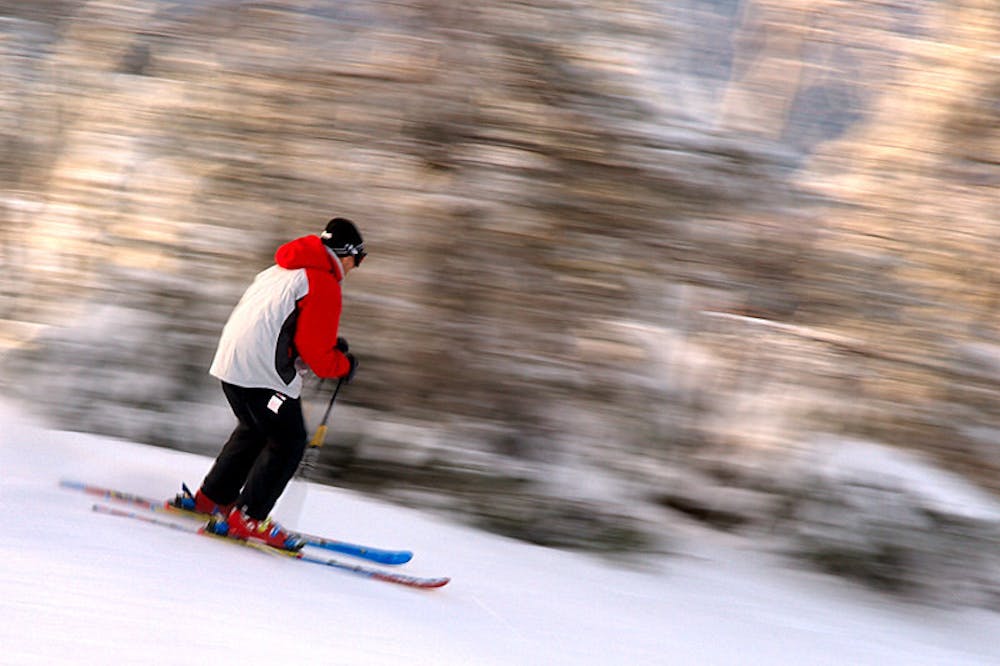
As I stood at the top of a ski slope in a terrain park, I looked down upon the 20-foot jump that my friends and I wanted to hit. One critical question arose in my head: How fast should we hit the jump?
For those of you who didn’t grow up surrounded by snow or haven’t tried out park skiing, hitting a jump in the park has two important caveats — you should never overshoot or undershoot. Hitting it too fast will lead to overshooting, which can send you flying past the landing and result in knee pain or even an anterior cruciate ligament (ACL) injury. Hitting it too slowly will lead to undershooting, which means landing too early and slamming onto the “knuckle.” This can hurt a lot, trust me, but, determined to find the sweet spot and make it back home without any knee pain, I asked the skier next to me.
“Just send it at a medium-ish pace,” he replied.
The rising scientist in me knew that the answer wasn’t so simple. From my experiences in research, I knew that I shouldn’t leave the fate of my knees up to chance. Instead, I should understand the science that can justify the most optimal speed to take off in order to land safely.
How did I find an answer to this question? Let me share my research experience at Hopkins with you.
In the summer after freshman year, I joined Xinzhong Dong’s lab, where we have been investigating Mas-related G-protein coupled receptors. With no prior wet lab experience, I was really intimidated by the thought of entering into a space dedicated to scientific research.
However, after spending around half a year in the lab, I realized that research is not that daunting. The research process can actually be found in everyday life — including skiing.
Research is precise. To generate reliable and accurate data, each step must be nicely controlled to isolate the effects you aim to measure. Furthermore, this process should be reproducible to yield the same results. The need for precision in scientific research means there is little room for human errors, demanding meticulousness and patience.
How did I apply this to the slopes? Through observing other skiers and reflecting on my past experiences, I hypothesized that speed was important in a successful landing. I quantified it as the number of turns I made before hitting the jump, which is easy to measure for multiple trials. After observing other skiers, I refined my hypothesis that the optimal speed to hit the jump would require two small turns before full sending to the takeoff.
Research can be high risk sometimes. The samples you are working with can be the accumulating result of months of work. One slip or addition of the wrong reagent means that all the culminating work might need to be redone. Therefore, it is always important to be careful when running experiments because scientific resources are limited and valuable.
Nevertheless, taking risks can still be crucial in research. Like my favorite catchphrase in skiing — “Full send or nothing” — once you think you have sorted everything out, go for it. It can be daunting to pipette your first reagents into cell samples, and running an experiment independently is definitely not a small feat. But if you never take the first step, you will never be able to perform an experiment or make any new findings!
Similar to research, skiing also requires taking risks. After refining my hypothesis, it was time for me to test whether two small turns preceding the jump would result in a successful landing. Although I was risking the possibility of hurting my knees, I would never know the feasibility of my hypothesis until I experimented with it myself.
Research happens in a collaborative environment that encourages collective efforts. In fact, the crucial point of research is to build on and contribute to an existing pool of literature. Researchers communicate with each other all the time through conferences, journal publishing or just a casual lunchroom conversation. Researchers must elaborate on scientific findings and articulate their implications in a way that is accessible to a broad audience. After all, research leads to new information and spreads these findings to expand human knowledge, and none of that can be achieved by a single person.
The ski park is also a collaborative space like the research community. After successfully landing my jump after making two small turns, I knew that my hypothesis-testing process could help my friends hit that jump. Therefore, I shared my experience to help them find the right speed at which they should hit the jumps.
Through my research experience at Hopkins, I have not only debunked my initial hesitations about scientific research but also gained a greater appreciation for scientists’ tremendous contribution to expanding our current understanding of the world. I also learned that the processes and skills I developed in research are omnipresent throughout our everyday lives. So perhaps my thoughts and reflection can inspire you to also get involved in research or to employ what you have learned in your research experience in your everyday life!
Research on the Record spotlights undergraduate students involved in STEM research at Hopkins. The goal of the column is to share reflections on the highs and lows that Hopkins students experience in their contributions to undergraduate research. If you are an undergraduate researcher interested in being profiled, reach out to science@jhunewsletter.com.





